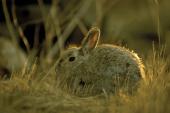
These animals are members of the mammalian order Lagomorpha. They have gnawing, constantly growing incisors, with a second pair of incisors directly behind, no canines, a long space between the incisors and premolars, well-furred feet, and nostrils which can be closed by surrounding muscles. They are herbivores and make more efficient use of their food by the process of reingestion, in which the defecated plant material, which is only partly digested in its first passage through the gut, is eaten and more thoroughly processed. They have several often large litters a year, and their populations can, if unchecked by predators or disease, grow very quickly. The order of approximately fifty-eight species is found naturally on all inhabitable continents except Australia. The four lagomorph species found in Saskatchewan are all members of the family Leporidae - the rabbits and hares, which have fairly long ears and long hind limbs.
The two species of rabbits are the uncommon Eastern cottontail (Sylvilagus floridanus), found in the southeast corner, and the more common Nuttall's cottontail (S. nuttalli) of the dry shortgrass prairies of the southwest. Rabbits are smaller and shorter-legged than hares; their young are born naked and helpless, and are kept in burrows until their hair and eyesight have developed. The two species of hares are the snowshoe hare (Lepus americanus) and the larger white-tailed jackrabbit (L. townsendi). Hares, particularly the jackrabbits, are longer-legged and longer-eared than rabbits; their young are precocious, born with fur and their eyes open. Both species are common; the snowshoe hare is more widely distributed throughout the province, apparently absent only in the Cypress Hills area. Both species change coats between winter white and summer brown.
Diane Secoy